‘The Twin Peaks Ending: Does Dale Fix His Heart Or Die?’ is now available on Audio, read by author John Bernardy, exclusively for our Patreon supporters. For just $3 a month you will have access to our full library of Audio content, plus three new uploads every week. To sign up visit our Patreon page: https://www.patreon.com/25YL
The debate is still strong two years later: is the ending of Season 3 a victory or a defeat?
Honestly, you can choose either answer with equal footing because both can be seen from where the film stops. With Dale and Laura back to starting positions in the Red Room, there’s an abundance of implied scenes where we get to see what grew from Dale’s realization and Laura’s scream.
David Lynch has always referred to the Red Room as a junction point, so having the potential to access both a positive outcome or a negative outcome from the end credits scene fits right in.
Imagine standing in a doorway. One way you can see the positive ending where Judy is defeated, and you can turn around and look into the ending where the darkness defeats everyone. Both can be logical conclusions. It just depends on which way Dale Cooper chooses to see the world. Does he take a golden shovel and “go out now”, or does he give in to fear and remain trapped in existential Lodgespace forever? We don’t know which he’ll choose based on where the show ends, but based on cycles we see in Season 3 we know Dale’s at the point where he can make a choice.
And that’s a main theme of Season 3 right there: you have to actively make a choice or you can’t move forward. But as Lucy asked an insurance salesman in her first scene of Season 3, “do you know which one? It could make a difference.”
Dale’s Choice, Not Laura’s
Why do I say it’s Dale’s choice rather than Laura’s (or both of theirs)? Because he asks the question “what year is this?” while Laura screams. Both reactions are acknowledgements of not knowing something, but Dale’s reaction implies he understands that he doesn’t know something. Laura’s scream is a visceral fear-based reaction.
Lucy screams when Frank Truman “suddenly” appears and Janey-E screams when Dale-as-Dougie sticks the fork in the socket. Neither Lucy nor Janey-E understand what they are seeing, but understanding does come later for both of them. Laura’s moment of breakthrough is similar: it is a confrontation with fear she was not ready for, nor able to understand in the moment. Laura’s scream implies a delay before understanding sets in.
Cooper’s breakthrough, on the other hand, comes with a level of readiness and understanding. Dale is the one who is waking up on that street in Twin Peaks.
Season 3 Is an In-Between State
But that street is not where Laura and Dale are in the end. They’re in the Red Room, a junction point between Lodgespace and the material world. Which is the perfect place for Season 3 to end because all my research suggests the entirety of Season 3 is a junction point. During the entire season we never see beyond this in-between state.
This article trades heavily in the conclusions I reached in my unified theory where I describe how I see the shape of reality in Season 3 and how characters navigate their way out of it. In that work I painstakingly show how I reach these conclusions, but here, I will not. Consider this the TL:DR version meant to be read in one sitting.
Usually, Lodgespace and physical reality run parallel, a material and non-material universe, with no middle state between them. Energy flows between the universes. But then Dale bodily entered the Red Room, his doppelganger switched polarities with him, and the red curtain barrier blew away. Now the states are tied together between when Dale enters the lodge and leaves it 25 years later.
And this middle state—just like all the other themes of three in Season 3—becomes a state all its own that is a junction point between the material and non-material realities. This in-between state moves its frequency gradually from material to non-material, from positive to negative, as it gets closer to Lodgespace.
Put in a chart, it looks like this:
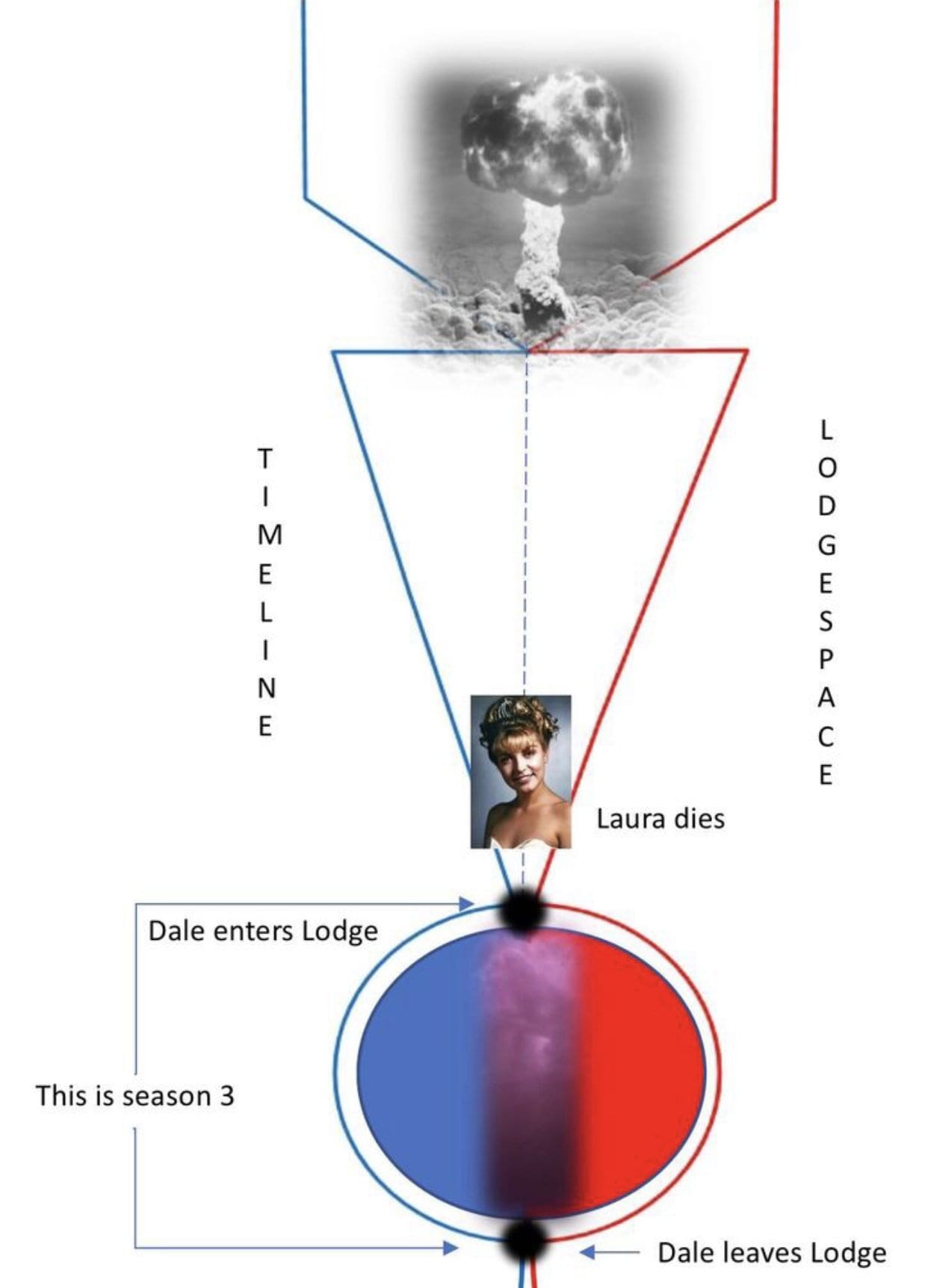
But why is the in-between state shaped like it is?
Because Dale Cooper is experiencing time loops and those time loops are layering on top of the same chronological point on the timeline. The loop points happen during two events which we see three times:
- “Is it future, or is it past?”
- Laura Whispers to Dale.
The first time we see these events in Season 3, Dale has the opportunity to believe Laura when she told him “you can go out now”, but he chooses to move on and follow the path as he tries to answer “Is it future, or is it past?” How to put it more plainly? Dale has a choice: leave the Red Room (as Laura suggests), or go further into the curtains (as Phillip Gerard motions him over that way). He chooses to go into the curtains; literally deeper into Lodgespace.
Here, I will break down the time loops into definitions so you know exactly what I’m referring to when I use loop numbers:
- 1st Loop: Timeline-adjacent, but the one that interrupts the natural timeline events (such as Hawk not meeting Dale as the Lodge curtains in Part 2). This is also where DoppelCooper makes the glass box and amasses his criminal empire and wealth while Dale is in the Waiting Room.
- 2nd Loop: This begins with Dale leaving through Non-Existence, then living as Dougie Jones, and ends in all the superhero stuff at the sheriff station. This is the only loop that specifically mentions Judy, Freddie, an unofficial version, or any plan between Briggs, Cooper and Cole. It’s also the only loop that includes Sarah Palmer as a possessed woman, Experiment, Experiment Model, or the Fireman and Dido sending a Laura orb into the world through their junction point.
- 3rd Loop: This is a dark world where very few people are. As far as I’m concerned, this is the dream Margaret warns Hawk about, and this is the one where Laura Palmer is Carrie Page and Diane somehow becomes Linda as she likely detaches from the dream midway through. This is Dale’s hubris run amok as he ignores the fact of genuine history.
- There is a 4th Loop that just begins as well. It could be a full reset because it begins with the whisper from Laura rather than “Is it future or is it past?” but we may never know because it begins in the final credits of Part 18 and is currently unfinished.
To show it in an image it looks like this:
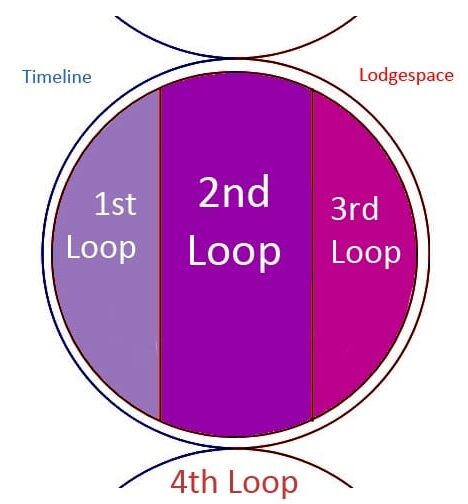
Up to now, everything I’m writing matches up well with everyone who says “Season 3 is all a dream.” But it’s more complicated than that.
All of the other non-Dale characters in Season 3 have much too much autonomy to be created from this. They’re from reality, and are still halfway part of reality, but they’re most certainly interacting with these Lodgespace-based time loops as it flows like a river at them.
Hawk. Electricity is humming. You hear it in the mountains and rivers. You see it dance among the seas and stars and glowing around the moon, but in these days the glow is dying. What will be in the darkness that remains? The Truman brothers are both true men. They are your brothers. And the others, the good ones who have been with you. Now the circle is almost complete. Watch and listen to the dream of a time and space. It all comes out now, flowing like a river. That which is and is not. Hawk. Laura is the one.
-Margaret Lanterman
Pamela Tarajcak of the Between Two Worlds Facebook group put it in a most easy to understand way: If Laura is the one, that could very easily be an answer to “that which is and is not.” Which means Laura is, and conversely Carrie is not. That’s also how I take it. The river of “dream” is made of that which is and is not, which means it fits within my idea that Season 3 acts as an in-between state.
Because the “dream” is essentially Dale’s time loops, and because each time loop is progressively more negative, that is why it feels like progressively more and more darkness flowing at Margaret and her material world.
The more frequencies added as Dale progresses through his journey, the heavier the weight of the “dream” state’s influence. And the longer Dale remains in this unofficial version of reality, the stranger the manifestation of his delusion gets for everyone who is tuned to a more negative mindset or experiencing fear.
The choice, just like the final scene, is to choose the negative dream or the positive material world.
Why So Negative?
But why is the in-between state leaning so far into the negative? The Black Lodge unleashed it.
Judy is the thing DoppelCooper is looking for. He also shows Darya a playing card with a black dot with wing ears and says this is what he’s looking for. Jow Day, therefore, can be that winged black dot.
And we all know from the Gordon Cole Speech in Part 17 that Jow Day is an ultimate negative force, which happens to be the direction the “dream” leans into. David Lynch has written in Catching the Big Fish about how a meditation state dissolves the proverbial “suffocating clown suit of negativity” made from anger, depression and sorrow, and Gordon Cole refers to “the clown comics” when he says “fix your hearts or die” in the first place. I have no problem connecting the dots between these statements to say an “ultimate negative force” is attempting to put its “clown suit” elements over an entire timeline by flowing over it like a river until the timeline is so delusional it doesn’t recognize itself anymore.
Delusion is when you show the whites of your eyes to what’s right in front of you because you can’t even bear to look at it. All that’s left to see is the darkness of your internal state. You’re driving blind through the world taking no responsibility for what you’re bodily causing while you’re experiencing your trauma outwardly. The closer to the negative dream, the more internal fears externalize.
Kylee Karre of the Twin Peaks Between Two Worlds Facebook group sums this up best with this comment: “I think much of Twin Peaks has always been about how we as humans refuse to look at the realities right in front of us, choosing to create our own versions of reality.”
People tuning to the frequency of a delusion seem easy to believe when you look at Steven and Gersten in the forest thinking he killed “her” when all they probably did was tune to a more negative frequency from Becky. Or when we’re presented with things like the zombie girl stuck in traffic.
But I’m straying from the black winged dot. Why bring it up here? The Evolution of the Arm’s doppelgänger has the black winged dot at the base of its mass. Gisela Fleischer spotted this top-notch observation and put together this collage of still images for our perusal.
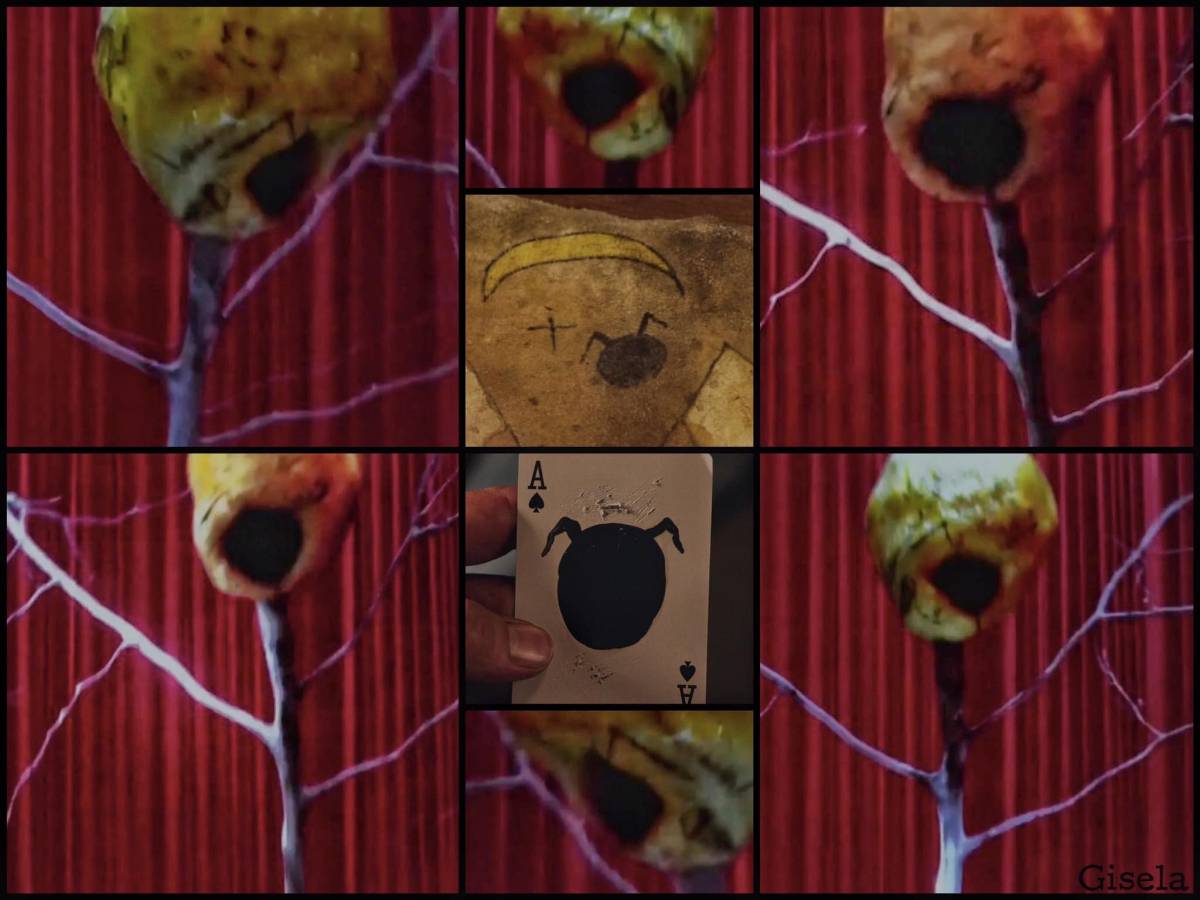
The Arm’s doppelgänger is the one that unleashes the delusion, the source (or more likely the junction point) of ultimate negative force. This happens right after Laura tells Dale he can “go out now.” Because he didn’t believe her, he’s sent instead to non-existence (the one that “is not”) which to me sounds like the dream delusion that eventually takes over in Part 18. The Black Lodge’s negativity is slowly asserting over reality—with nothing but appetite.
As Dale goes further into that dream, he leaves reality more and more behind. Except he also resets back to the beginning three separate times, in starting positions yet again. Dale experiences the time frames in linear fashion, rather than forgetting his experiences through the loops at each reset. He goes in order, but the timelines layer on top of the material world’s timeline, at different frequencies closer or further away from the timeline.
And because this is an in-between state, because Lodgespace has loose barriers with world once those curtains blow away, the material world experiences all three of these “timeline” frequencies at once. They just see one of the channels at a time, and which one depends on their point of view at the time. That understanding tunes to the frequency most in line with Dale at the time. And they choose which loop they’re seeing based on their current personal frequency.
If this is too abstract, here’s a metaphor:
Imagine sitting in your car. It’s always the same shape. But the radio could be playing different music. You’ll feel different if you turn on the classical music station or if you change the station to guitar rock. Or if you’re in the Roadhouse, you’ll be in a different state of mind if you’re listening to Trouble, or Lissie.
You have to know your frequency to be on it. To experience it. And over the course of Season 3, we’re shown the different frequencies in something that resembles this order:
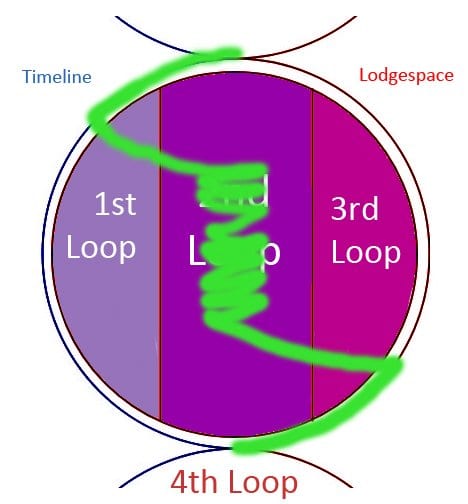
It’s All About Processing Trauma
While the shape of reality is formed by Dale’s fear-unleashed Lodgespace, and is the foundation of the in-between state of reality, its shape is also the external personification of Dale Cooper’s internal trauma cycle.

But what is Dale’s particular trauma? He lost. He went into the Lodge to fight the darkness but he was too confident and not ready enough. He did not win. Instead, the darkness took him from the world. And time has been pinched together between when Dale enters the Red Room and when he’ll eventually leave because he doesn’t know how to leave the Red Room yet. Except for his darkest parts, which are wreaking havoc on the world while Dale’s stuck in place.
This is a personified thing of what happens when a person experiences trauma. You retreat inward and the darkness has a chance of taking you over.
Dale’s time loops are an extreme version of the repeated behaviors we see people do in Season 3 (Norma doing the books in one of the Double R booths, in partially reused footage) rather than doing something to remove the need to do that soul-crushingly omnipresent work). When stuck in the middle of processing their trauma cycles, characters—including Cooper—expect the same behavior to yield different results as long as they keep repeating their actions. Cooper’s repeated behaviors just happen to be time loops.
In Season 3, the characters have entered their trauma but haven’t left it. That’s why they’re captured in Dale Cooper’s 2nd time loop. They can look out onto the positive frequency of the 1st loop and the negative frequency of the 3rd loop. They are all able to choose which way to direct their energy, but can only choose when they are ready to.
Characters only leave the in-between construct of Season 3 if they confront the cause of their trauma and actively decide how to direct their energy. If they can’t do that, they begin again at the starting positions of their behavior. Because “it’s more comfortable” to do the same thing than to make a true change.
Dale getting through his trauma cycle is the plot of Season 3. Everyone else’s story feeds into this theme. We can use others’ decisions and events that led from them to puzzle through how Dale decided and what could happen at the end. For storytelling reasons, this is why all the character vignettes are included in Season 3; they may not give us a character’s full story arc but they give us characters arriving at making a decision to use their energy positively or negatively. And this is valuable information.

How to tune:
- Positive: accept help, become aware, earn shovel, use shovel. Be an active traveler. Nadine Hurley exemplifies this.
- Negative: believe pain is insurmountable, believe fear, create delusion that separates you from others, be blind to what’s really happening to you. Be a passive passenger. Sarah Palmer or anyone who follows DoppelCooper exemplifies this.
When a character finally choose a positive direction (fixes their heart) or negative direction (dies) once and for all, this is when they leave the junction point of Season 3 and rejoin the timeline, or remain in the Lodge and become lost.
The Final Scenes
The main question at the end of Part 18 could be framed like this: there is no sound of electricity in the final Lynch/Frost Productions logo, so what does that mean? Is Judy no more?
It’s simpler than that. For Dale Cooper it means one of two things: He’s expunged his fear by pushing through it (fixed his heart) or he’s lost in the delusion forever (died). It can reasonably be either option.
Whether Judy and/or delusion has been defeated, or the dream dies with Dale as he goes into it, the electricity associated with the Black Lodge goes away. And either way, he’s made his choice in the end.
Does Dale show the whites of his eyes to the world as he fully embraces the delusion? Did he take the nightmare with him when he died just as Jean Renault hypothesized? Laura is back in the room with him. Did he join her in the Lodge forever, never to be seen in the material world again?
Twin Peaks can be a story about an agent who goes in and saves a girl from death then wakes her up and she’ll be alive. If you want to believe the story Dale was telling himself, go ahead. Television is a medium of delusion and fantasy, the “dream factory.” It works well as a concrete defeat of a trauma Dale thinks Laura was living with.
But that was a conclusion brought on by a portal that Phillip Jeffries assures Dale “is where you will find Judy.” And Judy, as I’ve said earlier, is delusion.
Dale Cooper has the chance to choose to “wake up” from the oversimplified conclusion that removes the central trauma of Twin Peaks—the murder of Laura Palmer—as well as removing the agency from Laura to choose to head into a situation that ends with her angel in the closing moments of Fire Walk With Me.
Twin Peaks can also be a guide through trauma that asks us questions, rather than supplying answers. We have to come up with our answers ourselves. Do you want to feel like everything is fine and the day is saved, or do you want to look inside and stare down the thing that scares you for hopefully the last time?
“What year is this?” is an active question meant to better understand the current place. It’s not unlike how Dale Cooper reacted to Lucy’s listing of the Season 1 finale cliffhangers: “How long have I been out?” This is probably the moment Dale actively chooses his shovel and begins to dig himself out of his delusion.
Will he take responsibility for all his and his doppelganger’s actions while he was living in a delusional state? When he believed certain things to be true that were not true? He’s taken the journey over 18 parts and he’s had plenty of time to think and understand. I have high hopes he’ll be able to walk up to his Red Room roommate Laura and paraphrase the speech Nadine Hurley gives to Big Ed when she finally decides to literally use her golden shovel for the first time:
“[Laura], I’ve come to tell you I’ve changed. You know I love you so much. But I’ve been a selfish bitch to you all these years, and you’ve been a saint. I’ve known since forever you love [your angel] and she loves you. I kept the two of you apart because of my jealousy. And I manipulated you, [Laura]. You know it’s true. I guilted you to stay, and you’re so good you stayed and gave up your love. Oh, God, [Laura], I want you to be free. I’m fine now. You asked about this shovel. Well I’m shoveling myself out of the shit. Don’t worry about me. Run to her. Enjoy the rest of your [existences] together. I am so happy just thinking of you two being happy.”
Just like Dale going through three time loops before he was able to ask “what year is this?,” Nadine had to tell Ed three times in her speech that he was free before Ed believed her. What does Dale understand when Laura whispers to him for the third time? Hopefully this: “You can go out now.”
The Golden Shovel
The three times it takes to understand actually matches with what we are shown of the golden shovels:
In Part 1 we saw the shovels arrive but didn’t know what they were or where they were going. All we knew by the end of the extended scene was that Jacoby wanted this delivery. The next time we see the shovels, Jacoby is in his properly protective gear spraying a coat of paint. Then we finally see Jacoby in his full Dr. Amp glory and we’re shown how we’re supposed to use them. We see two of his commercials, then Jacoby meets Nadine in person. After that third time hearing about the shovels in Season 3, Nadine was able to use the shovel to let Big Ed free.
In regards to trauma, that matches up well:


At the same time Dale was stuck in the lodge, he was also forming his proverbial golden shovel, understanding. He was “far away” when the darkness defeated him, but over time, while he was processing trauma, he fortified his understanding with “two coats” of time loops. When he asked “what year is this?,” he was able to take his understanding in his hands and start using it.
And this is when Dale’s trauma cycle intersects alchemy and begins to look more like this:
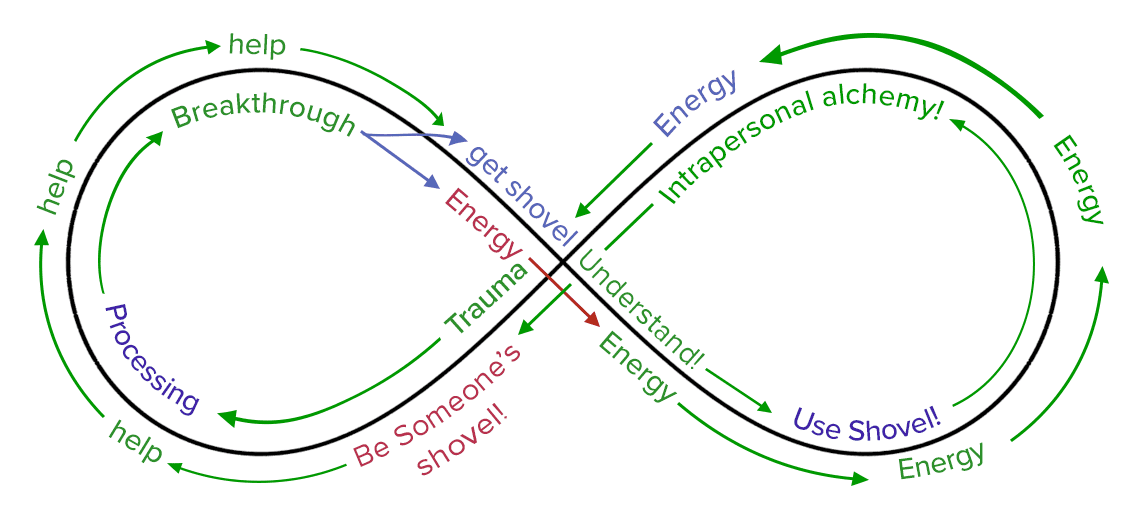
Dale went back to starting positions, but in the third time he sees Laura whispering to him, there is no Phillip Gerard shown in the wings waiting to ask him “Is it future, or is it past?” for a fourth time.
This time, all signs point to Dale’s having his shovel and being awake. Pattern says this is Dale’s time to choose, but what we want and what we need are separate things. The true answer about the ending to Twin Peaks is, we may never know if it was a positive or negative ending.
We can choose to believe Twin Peaks ended in a positive direction or a negative one. Or we could wait for an official version to give us a proper answer someday. It’s all up to us. The evidence has been presented. We’ve experienced Season 3. Now it’s up to what we choose to do with it.
If you’re left wondering how all the characters I haven’t mentioned (like Audrey) fit into this framework, or how I see the reversed scenes, purposeful glitches, the Fire Walk With Me poem, or how the Roadhouse explains the flow from one frequency to another, I encourage you to read further into the much more expansive larger version of the theory.


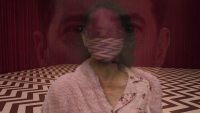
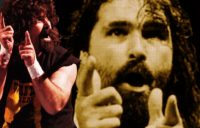

What? I had to read that twice to make sure I was correct in not understanding any of it? I’m a huge longtime Twin Peaks fan and have watch A3 several times and still can’t make any sense out of it. Entertaining and well acted (Harry Dean Stanton deserves accolades) , but no answers…just more questions. But what you wrote literally makes no sense to me.
Derek, we at least agree that there are only questions. I just think we’re supposed to choose how we see the ending based on how we choose to answer those questions.
If that doesn’t work for you I’m not offended…there’s plenty of theories that don’t resonate with me at all; I appreciate you reading twice to give mine a fair shake ??
Well written article. Like the theory. As you wrote the show/series might be more about personal interpretations of the questions and themes. The psychology themes in your article are explained well, something else to think about during another rewatch.
Repeating until it’s the same or isn’t.
Paraphrasing Mr. Palmer’s comments to Maddy.
‘We all want it to be the way it use to, but try as we must… doesn’t cooperate, does it.’
Could Dale’s trama have started with death of his partner’s wife? Or even his mother?
Or is FWWM season 1&2 &3 all a death dream as Dale bleeds out after Windom shoots him?
I lean towards it all Dale’s death dream because of the way fire walk with me, shows Dale in the white lodge with Laura. The Anne bleeding in the bed. Donna seeing and being involved in the red side of Laura, which doesn’t come up in Season 1-2. Knowing the movie was shot second, why add that and have Donna so delusional in TW1&2 And two versions of the Teresa Banks story.
Image Chris isstack as Dale Cooper for 3 seasons.
Hi Jeff,
Final Dossier implies Dale’s white knight syndrome goes back to helping his sick mother.
I can go with a death dream too. Trying to get my head around my trauma cycle where there’s birth, a whole bunch of life, then death where I have the point of breakthrough. I bet what you’re thinking overlays on that format really well.
You know, Mr. Bernardy, I have watched Seasons 1 & 2 probably 30 times now, Fire Walk with Me quite a few times, and The Return half a dozen times. I realized early on that The Return was a departure from the unusual but straightforward linear storytelling we had seen thus far. What I could never understand at all was the Monica dream, and seeing Dale’s face superimposed over the destruction of Bob. The best explanation of what could truly be taking place in The Return that I have heard before reading this was the one where the Fireman and Dido used Dale and Laura to lure Judy into a fabricated reality, the “what year is this” reality, trapping “her” there, and ultimately sacrificing two pawns who were set in motion early on for the long haul, the White Lodge inevitably victorious. But as much as that made sense, it left no room for the “dreamers dream” ideology, which is heavily peppered all throughout season 3 in a multitude of ways. The “alternate reality trap” only guesses at much of what the insinuated dream reality/fabrication thru black lodge energy, Cooper’s influence thereof, and the timelines/alternate realities spilling forth and washing over everything could actually mean and/or imply. I appreciate your obviously thorough, creative, in-depth, and intelligent point of view on The Return. I love Twin Peaks, simply because no answers for The Return can be found by going back to the original source material before it. To me, that’s the obvious point of the 3rd Season. I also realize that Lynch and Frost, just as you also similarly stated at the end of this review, covered a great number of issues plaguing humanity. We can’t look behind us, back at the good ol’ days, in hopes of finding answers to fix the issues/problems in front of us. It’s all about what we choose to do moving forward. Do we open our eyes, or dream about self-perceived better times in the past, and live in the delusion that times were actually better then, that we can somehow bring back what has already come and gone, a delusion? If the world seems to be getting worse; i.e., honking/raging women, random children firing pistols into crowds of people, children getting run over with no regard, drugs consumed by troubled youth, drug suicide, veteran suicide, mental health issues worsening, ignorance, stupidity, lust for death, murder, underpaid teachers, forgotten elders suffering, terribly made modern automobiles, postal road ragers, intolerance, mothers nodding out in front of unsupervised children, etc., are we going to keep showing the whites of our eyes, ear buds blasting, faces buried in screens, mind altering anythings doing what they were made to do, simple indifference, live in the past, Negative nothingness? Or will we rise to the occasion, reach out a hand to our struggling humanity, do the next right thing, put the distractions away, remember nature, own our part in this modern world, live for the future, Positive reinforcement of what we believe to be true? Hate, greed, lust, despair, grief? Or love, tolerance, patience, understanding, community? I believe you’re right, just like what you said about Dale: the choice is ours.
Food for thought: when Monica looked over Cole’s shoulder, she was looking at (in real life) the corner of Montparnasse and rue d’Odessa.
I appreciate the time and energy you put into this, but most of it doesn’t ring true to me because I disagree with the interpretation you used as a jumping off point. When Laura told Cooper he could go out now, that was a signal for him (and to the audience) that after 25 years in the lodge he was finally able to leave as Mr.C would be sucked back in (the arbitrary rules of this world). She was speaking in general terms, “you can go out now”, now is the time, finally. Of course that isn’t what happens because of Mr.C’s careful planning, which he says as much .”I’m supposed to get sucked back into what they call the black lodge tomorrow. But I’m not going back. I have a plan for that one”. Also the doppelganger of the arm’s interference.
So I don’t think there was any choice to be made when Laura said he could go. Hawk was there because, had the rules laid forth by the lodge gone as they were supposed to, Cooper would have exited at Glastonbury grove and Mr.C would have been sucked back in, and Hawk would be there to greet him (because he knows things).
I also don’t understand all the energy or loop stuff. But then again, out of all the theories I’ve read from people trying to explain season 3 and specifically final episode, I have yet to come across anything that’s really truly satisfying. It seems there isn’t any one real answer that will make everything fit nicely, simply because we don’t have enough information. Just like when FWWM came out and we only had a few strange mentions of a “Judy”, not nearly enough to draw a conclusion about, but just enough to lead to some wild speculation. In that spirit, with The Return, we got more on the Judy mystery, but typical Lynch, we still end up with more questions than answers.
I like the interpretation of season 3 being a dream, and a junction point. In seasons 1 and 2 the Lodgespace is much clearer divided from everyday reality, but in season 3 the Lodgespace is always present in Dougie Cooper’s life. And when he wakes up in the hospital, he exchanges a ring and a strand of hair with MIKE directly, so the Red Room and the hospital room must have been in the same room, the hospital room layered over the Red Room.
I also like the equation of Judy with the state of delusion. I’d add spiritual death and physical death.
One thing though, I would rather not speak of a fourth loop, except when you think that Dale and Laura are eternally trapped(?) in the Red Room and always come back from their dream adventure, no matter what decisions they made.